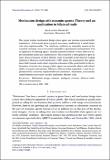| dc.contributor.author | Wolitzky, Alexander G. | |
| dc.date.accessioned | 2017-06-21T20:14:47Z | |
| dc.date.available | 2017-06-21T20:14:47Z | |
| dc.date.issued | 2016-09 | |
| dc.date.submitted | 2015-10 | |
| dc.identifier.issn | 1933-6837 | |
| dc.identifier.issn | 1555-7561 | |
| dc.identifier.uri | http://hdl.handle.net/1721.1/110157 | |
| dc.description.abstract | This paper studies mechanism design when agents are maxmin expected utility maximizers. A first result gives a general necessary condition for a social choice rule to be implementable. The condition combines an inequality version of the standard envelope characterization of payoffs in quasilinear environments with an approach for relating agents' maxmin expected utilities to their objective expected utilities under any common prior. The condition is then applied to give an exact characterization of when efficient trade is possible in the bilateral trading problem of Myerson and Satterthwaite, 1983, under the assumption that agents know little beyond each other's expected valuation of the good (which is the information structure that emerges when agents are uncertain about each other's ability to acquire information). Whenever efficient trade is possible, it may be implemented by a relatively simple double auction format. Sometimes, an extremely simple reference price rule can also implement efficient trade. | en_US |
| dc.language.iso | en_US | |
| dc.publisher | The Econometric Society | en_US |
| dc.relation.isversionof | http://dx.doi.org/10.3982/TE2089 | en_US |
| dc.rights | Creative Commons Attribution-NonCommercial 3.0 Unported | en_US |
| dc.rights.uri | https://creativecommons.org/licenses/by-nc/3.0/ | en_US |
| dc.source | Society for Economic Theory | en_US |
| dc.title | Mechanism design with maxmin agents: Theory and an application to bilateral trade | en_US |
| dc.type | Article | en_US |
| dc.identifier.citation | Wolitzky, Alexander. “Mechanism Design with Maxmin Agents: Theory and an Application to Bilateral Trade.” Theoretical Economics 11, no. 3 (September 2016): 971–1004 © 2016 Alexander Wolitzky | en_US |
| dc.contributor.department | Massachusetts Institute of Technology. Department of Economics | en_US |
| dc.contributor.mitauthor | Wolitzky, Alexander G. | |
| dc.relation.journal | Theoretical Economics | en_US |
| dc.eprint.version | Final published version | en_US |
| dc.type.uri | http://purl.org/eprint/type/JournalArticle | en_US |
| eprint.status | http://purl.org/eprint/status/PeerReviewed | en_US |
| dspace.orderedauthors | Wolitzky, Alexander | en_US |
| dspace.embargo.terms | N | en_US |
| dc.identifier.orcid | https://orcid.org/0000-0001-7277-4118 | |
| mit.license | PUBLISHER_CC | en_US |
| mit.metadata.status | Complete | |
